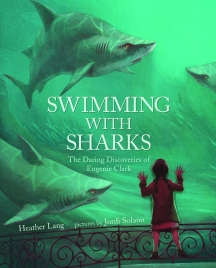Jordi Solano is the illustrator of Swimming with Sharks: The Daring Discoveries of Eugenie Clark by Heather Lang. He was kind enough to sit down with us to describe the process of illustrating Swimming with Sharks.
Let me begin by saying that Swimming with Sharks is my first book with an international publisher. So when my agent Hannah told me about this one, the first thing that came was uncertainty, like the first day going to a new school, when you might be a bit scared but at the same time you really, really want to do well.
Then Jordan [Kost], the art director [at Albert Whitman & Company], introduced herself and told me what the book was going to be about. I remember her telling me about Eugenie Clark, who she was, what she did. She told me there were already several books published about her, and that we needed to make ours stand out from the rest. After some quick research, I told Jordan that all those books published about Dr. Clark had their focus on her being a scientist, on her amazing discoveries. Meanwhile, I was under the impression that Swimming with Sharks was a completely different thing: to me, it was the story of a little girl who had a wish, and of how she grew up to fulfill it. This has been my main thought while working on the pictures for this book.

Jordan has really been very helpful throughout the process. She provided a ton of visual references, gave me useful advice every time I had trouble planning one of the images, and, in general terms, she has done an amazing job to make the book better and helped me save a lot of time by doing a huge amount of research.
And so the work began. I always start by doing lots of sketches, to make myself familiar with the stuff that will appear in the book. This means that I filled several pages with drawings of sharks, fish, and people diving. While most of them were left within the pages of my sketchbook, a few ended up being developed into some of the illustrations you can see in the book, because they already worked well enough on their own.
After this “let’s make myself familiar with stuff” stage, it comes what I consider to be the single most important part of the work. What I do at this point is print a layout of the book (that is, the blank pages with only the text with the final placement) and, while I read it time after time, I start doing very small rough sketches that show the composition for every illustration. After this two-inch sketch roughs are finished, the book is already in my head: I know how I want it to look. Afterwards it’s a matter of developing the idea and making the final result look as close to it as my own ability allows.

Having the clear idea of what I want to do, now it’s time to start doing it. First thing here is the line work. This is important because it’s the first thing that Jordan and the rest of the team will see, and therefore I want it to be very precise. If I feel the drawing doesn’t explain the image in my mind well enough, when I send it to Jordan I would add a short comment, such as “this one will have a very strong atmosphere” or “a warm, yellow-ish light will come from that direction,” so the team can figure out what I am planning to do.
Once Jordan and the team had revised the sketches, they would send feedback and some adjustments would be made. They have usually been minor aspects of the drawings, things like “Make sure Genie’s eyes properly show that she was half Japanese” or “Beware! You’ve drawn the shark’s gills too close to the eyes.” After these arrangements have been made, it’s time to go on to the color.

This is the stage that I’ll spend more time working in, and one that I really enjoy. I begin by doing high resolution scans of every drawing, since I’ll be using the computer all the time here. Even though I paint digitally, I like to keep it as natural as possible, much like when I used to paint with oils. This means that I don’t like to use lots of layers or digital effects, but still, working this way allows me much more flexibility, lets me try things I wouldn’t do otherwise (because there’s a very good chance that if I try them on paper, I’ll end up ruining the illustration I’ve been working in for so many hours). And last, but not least, I can work quicker this way, since I don’t need to clean the brushes all the time and wait for the colors to dry. This is indeed very good for the deadlines.
Once the color has been done and I’m happy with the result (I’m usually my own worst critic), it’s time to send the finished images to Jordan. She’d usually say how awesome they are and we would all be happy after a beautiful book has been made. Hooray!

Thanks, Jordi! Dive into Swimming with Sharks today, plus find out more about the author, Heather Lang here.

You must be logged in to post a comment.